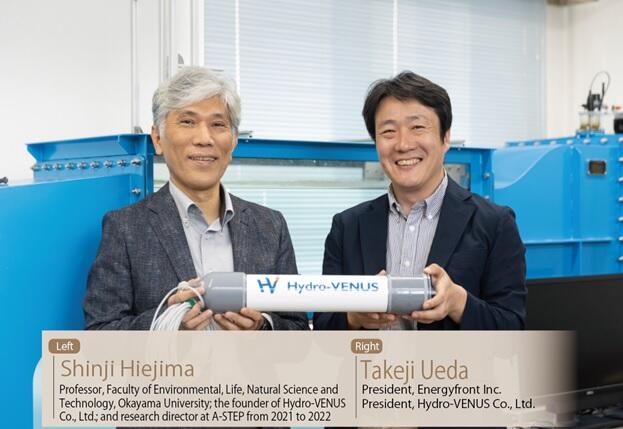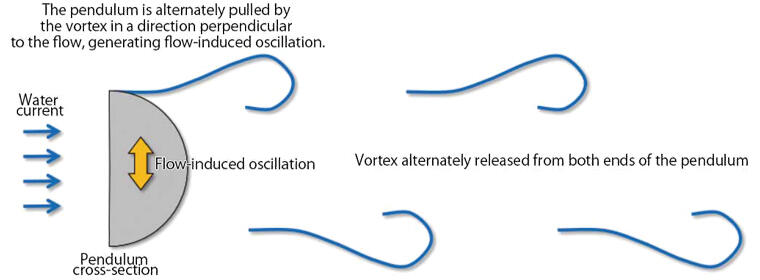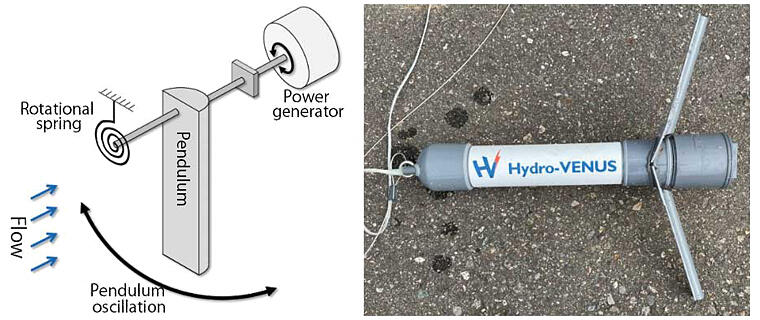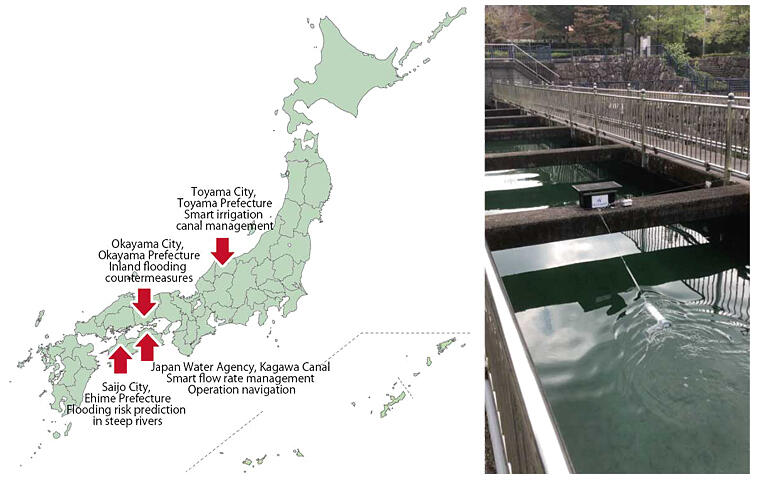In the segment 'A Look Around Innovation,' we introduce research and development (R&D) sites that have led to societal impacts in the future. In this 9th installment JST News visited Professor Shinji Hiejima of the Faculty of Environmental, Life, Natural Science and Technology at Okayama University. He is working on the development of a flowmeter to monitor flooding in small and medium-sized rivers as a precursor to flooding using water current power generation technology based on "flow-induced oscillation" in which objects oscillate under the force of water or wind.

Flow-induced oscillation with powerful force: Focus shifts from control to envisioned use — Okayama Prefecture is known for the Seto Ohashi Bridge, the world's longest rail/road bridge.
Located in the center of the prefectural capital, Okayama City, is Okayama University's Tsushima campus. Despite its location in the urban area, the campus boasts an area of approximately 640,000 square meters, which is the equivalent of 13 Tokyo Domes. Hiejima of the university's Faculty of Environmental, Life, Natural Science and Technology has been conducting original research in this area. His research is conceived from bridges and tidal currents of the Seto Inland Sea.
Hiejima was born in Iwakuni City, Yamaguchi Prefecture, and grew up within sight of the Kintai Bridge, which is one of the most famous wooden bridges in Japan. The bridge is approximately 200 meters long and consists of a series of five beautiful wooden arches that fascinated Hiejima because of the mechanical beauty inherent in the bridge. "When I was in university, that was exactly the time when the Honshu-Shikoku bridges, such as the Seto-Ohashi Bridge, were opened. In graduate school, I joined the bridge engineering laboratory and learned about 'flow-induced oscillation,' which eventually led me to my current research topic," he said, explaining the impetus for his research.
Flow-induced oscillation is a phenomenon that causes structures, such as bridges, to oscillate owing to the "vortex" generated by the flow of wind, water, and tides. This oscillation is characterized by continuous amplification due to the action of the fluid and possesses enormous power capable of causing bridges to bend and collapse (Figure 1). Hiejima has been conducting research on the method of controlling flow-induced oscillation for many years. One day, however, he came up with a revolutionary idea to "harness" the power of oscillation. "I thought that it might be possible to obtain renewable energy in an efficient way through tidal current power generation, which uses the oscillations caused by water currents."
Figure 1:Flow-induced oscillation

Resistant to breakage due to the shape of the pendulum: Operation even in narrow and shallow streams
From this background, Hydro-VENUS, a power generation system utilizing the flow-induced oscillation of a pendulum, was born. It is the key technology of this development. To generate electricity, Hydro-VENUS is oscillated by the power of the vortex alternately released from the left and right sides of a cylindrical or semicylindrical pendulum placed in flowing water. The most common tidal current power generation that uses water flow is typically of the type that involves rotating propellers to generate electricity. However, propeller blades are susceptible to breakage if, for example, drifting debris (e.g., fallen leaves) are entangled and may potentially harm animals and plants in the water.
In contrast, Hydro-VENUS, with a pendulum shape, eliminates these concerns as it operates with a reciprocating motion, making it less prone to breakage. Furthermore, its simple shape does not impede the flow of water and allows operations in narrow and shallow streams. The Hydro-VENUS system can be used in a variety of flows, including rivers and seas, as well as irrigation canals, the water supply, and sewage systems (Figure 2). In 2015, Hiejima established the venture company Hydro-VENUS Co., Ltd. It was launched together with Okayama University with the aim of promoting the adoption of the system, which converts water flow into an energy source.
Figure 2:Hydro-VENUS system

The key person behind the foundation of Hydro-VENUS Co., Ltd. was Takeji Ueda, the current president of the company. As an advisor in industry-academia collaborations exploring expansion in the energy sector, Ueda met Hiejima through Professor Naoshi Ikeda, Faculty of Environmental, Life, Natural Science and Technology, Okayama University. "[Professor Ikeda] introduced me to Dr. Hiejima with the words, 'If you want to be in an energy-related business, you should help him.' When I actually saw Hydro-VENUS in his laboratory, I was very impressed that this was such a fascinating technology," recalled Ueda.
Hiejima, on the other hand, felt frustrated by the difference in enthusiasm toward social implementation while working with several companies. The two shared a common desire to spread the benefits of Hydro-VENUS from Okayama throughout the world. With the momentum of their mutual understanding, the following year after they met, they founded Hydro-VENUS Co., Ltd. In October 2023, the company was selected for J-Startup WEST, an award given to startup companies with advanced business activities and ambitious initiatives aimed at solving regional and social issues promoted by the Chugoku Bureau of Economy, Trade and Industry and the Shikoku Bureau of Economy, Trade and Industry.
Demonstration experiments conduction in the Chugoku and Shikoku regions as well as in Toyama Prefecture: Hopes of playing a role in "Flood Control Digital Transformation (DX)"
In 2021, Hiejima and his colleagues were selected by JST for the A-STEP (Adaptable and Seamless Technology Transfer Program through target driven R&D) project "Development of low-cost, external power supply-free flowmeters for the construction of a flood damage prediction sensing network," and they began developing a flowmeter using the Hydro-VENUS system. The background for this project is the heavy rainfall disasters that have been a problem in various areas of Japan in recent years. Heavy rainfall occurred in western Japan in 2018, causing extensive damage in Okayama Prefecture, with the entire area of Mabi-cho, Kurashiki City, submerged in water. One of the factors for the expansion of the damage was the collapse of the banks of small and medium-sized rivers that are tributaries of the Takahashi River—a first-class river—and inland flooding of irrigation canals. In general, however, water level gauges and flowmeters that detect abnormalities, such as rising water levels, are not installed in many small and medium-sized rivers due to cost issues.
Hiejima talked about his resolve at that time, "From this background, we took on the challenge of developing a new flowmeter that does not require a power source and is low-cost through the application of the Hydro-VENUS, which can generate electricity from water flow." The participants in the A-STEP project worked to improve energy harvesting performance and robustness against drifting debris, with a view toward installation in rivers and waterways. To achieve both, pendulums with different cross-sectional shapes were tested. Findings showed that a pendulum with a semi-elliptical, cross-sectional shape produced the strongest flow-induced oscillation. Furthermore, by increasing the length and tilt angle of the pendulum, the project team was able to reduce the entanglement of drifting objects and improve energy harvesting performance.
Demonstration experiments based on the results of the A-STEP project are already underway. The application of the Hydro-VENUS system is being verified as a key solution to problems in various areas, such as inland flooding countermeasures in Okayama City, flooding risk countermeasures in Saijo City, Ehime Prefecture, and irrigation canal management in Toyama City, Toyama Prefecture (Figure 3). Negotiations with various local governments and relevant organizations are mainly conducted by Ueda. He said, "Although we face many challenges, such as unique regional issues and coordination with all stakeholders involved, this is a technology with significant potential, and we sense a high level of interest. We hope to continue to play a role in 'Flood Control DX' as a technology to realize flood damage prediction and sensing in the future." Flood Control DX is an approach that makes full use of AI to improve disaster prevention capabilities in river basins.
Hiejima and Ueda are exploring how to use marine energy as an industry unique to the Seto Inland Sea. Japan's seas are called satoumi, which nurture abundant gifts, such as fishery resources and scenic beauty of the islands. Many straits of various sizes in the Seto Inland Sea make it one of the world's largest treasure troves of tidal energy. "We are now envisioning if we could create a new tidal current power generation system with Hydro-VENUS aligned on the seafloor. Hydro VENUS would enable the local production and consumption of 'satoumi energy' and contribute to the improvement of energy self-sufficiency." With innovation born from a bridge, Hiejima is looking toward the realization of a sustainable society.
(TEXT: Manami Yokoi, PHOTO: Hideki Ishihara)
Figure 3:Demonstration experiments for Flood Control DX





